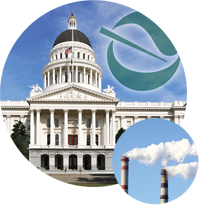
Mitigation Support
A project that is ultimately determined to have significant air quality, health risk, or greenhouse gas (GHG) impacts is required under the California Environmental Quality Act (CEQA) to provide mitigation to the extent feasible. The goal is to reduce impacts to less than significant with mitigation incorporated as a condition of project approval. Otherwise, the Lead Agency would be required to prepare and publish a Statement of Overriding Considerations in order for a project with significant impacts to proceed.
Mitigation measures are a means of reducing impacts, either directly by reducing emissions at the project source (controls and technology improvements) or indirectly using emission reductions achieved elsewhere and allocated to the project (offsets and sequestration).
Mitigation measures for stationary source operational emissions include:
- Implementation of more efficient emission controls than otherwise required by Air District rules and regulations;
- Replacement of old high-emitting equipment with new lower-emitting equipment;
- Implementation of lower-emitting alternate basic processes where applicable; and
- Providing permanent emission offsets in excess of those required under New Source Review (NSR) rules.
Mitigation measures for temporary mobile source emissions, such as construction, include:
- Use of newer construction equipment and trucks with lower-emitting diesel engines, particularly heavy earthmoving equipment with large diesel engines;
- Implementation of after-market emission controls not otherwise required by State or federal regulations for certain categories of equipment, i.e., verified diesel emission control strategies (VDECS);
- Use of biodiesel fuel; and
- More frequent application of water for enhanced dust suppression, use of dust palliatives where effective, routine street sweeping outside construction site, and extensive wind fencing to reduce fugitive dust entrainment.
Mitigation measures for operational GHG emissions include:
- Energy efficiency surpassing Title 24 standards – high efficiency equipment and lighting;
- Water efficiency and conservation – plumbing fixtures and landscaping;
- Waste reduction and recycling – facility and municipal programs; and
- Carbon sequestration – on-site landscaping and off-site tree planting.
Under CEQA, control strategies otherwise required by State or federal regulations cannot be claimed as mitigation. As such, control and technology mitigation measures must reduce emissions to levels below those needed for regulatory compliance. For example, if the current rule limit for a gas-fired commercial boiler is a NOx concentration of 30 parts per million by volume (ppmv) without add-on controls, voluntarily installing Best Available Control Technology (BACT) under permit to further reduce NOx to 6 ppmv – an 80% reduction – would be considered mitigation, and the reduction in NOx mass emissions associated with the voluntary 24 ppmv decrease could be debited from the project emissions balance. Similarly, offsetting emissions only in the amount required under NSR rules cannot be claimed as mitigation; however, offsets provided in excess of the minimum amount can be claimed as mitigation.
As a specialty air quality firm, Yorke Engineering, LLC is well versed in mitigation options and emission control alternatives for a wide range of stationary and mobile emission sources. We have extensive compliance experience with hundreds of commercial and industrial projects. Our experience is applied to each new project to ensure that we recommend the most efficient, cost-effective solution to reduce compliance costs and ensure the least disruption to construction and operational activities.
Not only can Yorke recommend mitigation measures that will aid in getting the CEQA document for the project approved, but we can also provide for mitigation support during the approval process and after approval. For instance, many CEQA approvals include a requirement to prepare a Mitigation Monitoring and Reporting Program (MMRP), which details the mitigation requirements, how they will be implemented, and how compliance with the required mitigation measures will be demonstrated. In some cases, the MMRP is prepared as part of the final Environmental Impact Report (EIR) or other CEQA document, but its preparation can also be a requirement as part of the approval process. Yorke can assist with the implementation of the MMRP, as well as its preparation. For instance, Yorke staff have acted as the on-site Air Quality Construction Mitigation Manager during construction of major projects. Our staff have also tracked construction vehicle usage and emissions to ensure compliance with engine certification and other mitigation requirements.
